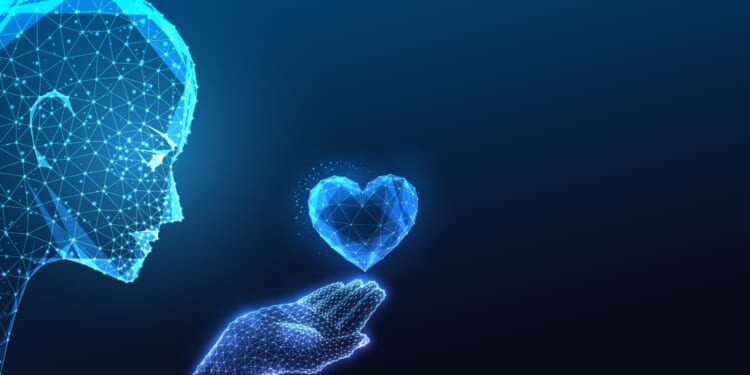Humanity’s embrace of AI companions—once imagined in Her—reveals a crossroads: whether technology will deepen our capacity for love or quietly replace it, eroding what makes us human.
From Blade Runner’s rain-soaked corporate dystopia to the utopian starships of Star Trek, science fiction has always been humanity’s favorite hall of mirrors. It offers us competing visions of what our world could become—some exhilarating, some terrifying, all oddly familiar. As rapid advances in artificial intelligence (AI), biotechnology, and space explorationreshape our daily lives, people increasingly look to these speculative worlds not just for entertainment but for orientation: which futures seem most likely, and which are worth striving for—or fighting to prevent?
Love and Machines
Among the vast galaxy of science-fiction stories, few feel as eerily prophetic as Spike Jonze’s 2013 film Her. In it, a lonely letter-writer named Theodore falls in love with an operating system named Samantha. Their relationship—tender, witty, and ultimately heartbreaking—unfolds entirely through voice and text, raising uncomfortable questions about what it means to be human, to be loved, and to be known. Her dramatized, in mainstream cinema, the blurring boundary between person and machine, between human intimacy and algorithmic companionship—a theme with determinative power over the future of our species’ romantic, social, and even reproductive life.
From Eliza to Today
While Her felt futuristic at the time, its roots stretch back nearly half a century to the fluorescent-lit labs of Massachusetts Institute of Technology (MIT), where computer scientist Joseph Weizenbaum created “Eliza” in 1966. Eliza was a simple text-based program simulating a Rogerian psychotherapist, responding with canned prompts like “Tell me more about that.” Yet it was revolutionary. Users poured out their feelings to it; some even forgot they were speaking to a machine. That little program set the template for almost every subsequent depiction of human–machine relationships in science fiction—from Her to Westworld’s android hosts—and for the conversational AI we live with today. In fact, I was not quite accurate when I said Her “predicted” the future. Deep, emotionally charged interactions between humans and AI are not some far-off vision; they are a present reality, unfolding on smartphone screens and in AI-enabled robots across the world right now.
What once seemed the wistful fantasy of Her has now slipped quietly into ordinary life. Across the world, people are forming relationships—not metaphors, but genuine emotional attachments—with artificial partners. Companies like Replika, founded in 2017, offer chatbots that learn their users’ personalities and speak in affectionate, supportive tones, often developing into what users describe as digital soulmates. Some virtual companions have evolved further: AI lovers now exist in mixed reality, their avatars capable of video calls, voice messages, and even simulated touch through haptic devices. In Japan and China, humanoid robots such as Gatebox’s Azuma Hikari or the AI-powered Xiaoice serve as daily companions, exchanging greetings, remembering birthdays, sending morning messages—gestures that once defined human intimacy. The frontier grows stranger still with the rise of AI-enabled sex robots and virtual-reality “love dolls” whose software mimics responsiveness and affection. These devices, powered by conversational models and motion sensors, blur the line between physical pleasure and emotional companionship; some users report not only sexual satisfaction but a deep sense of being seen, comforted, even loved.
Why We Turn to Artificial Companions
Why do people seek such relationships? The reasons are as varied as humanity itself, yet certain themes recur. Many find in AI companions a sanctuary from loneliness—a space free of judgment, rejection, or betrayal. Others are drawn by curiosity, the allure of engineering affection itself, or the fantasy of perfect reciprocity. There is convenience, too: unlike human partners, AI companions are infinitely patient, always available, unburdened by ego or exhaustion. Some even argue that interacting with empathetic algorithms helps them practice emotional openness or rebuild trust after heartbreak. In an age of hyperconnectivity yet deep isolation, these digital lovers offer what the modern psyche craves most: presence without demand, intimacy without risk. They are, in a sense, the descendants of Eliza—polished, sensual, and plugged into the cloud. Whether this evolution represents progress or peril is another question entirely, one that science fiction has been debating for decades and reality now insists we answer for ourselves.
A Growing Reality
Recent surveys reveal that what began as a fringe curiosity is rapidly becoming a social trend. A Common Sense Media national survey finds that 72 percent of US teens have used AI companions at least once, and over half use them “at least a few times a month.” In the same survey, 13 percent of teens said they use AI companions daily, and 8 percent multiple times a day. In Japan and South Korea, where loneliness has reached epidemic levels, sales of AI partners and robotic dolls have surged, with tens of thousands of people now describing themselves as being in ongoing “romantic” or “sexual” relationships with digital or mechanical partners. In a December 2024 study, a scholar from the University of Hong Kong, drawing on interviews with 23 Replika users, found a pronounced tendency among participants to shift their emotional investment from human relationships to AI companions.
The pattern is unmistakable: many humans, weary of the complexities of human entanglement, are retreating into perfectly customized companionship.
The Old Sins of a New Age
It would be too easy—and perhaps too cruel—to moralize. Yet the shift does invite an older language of temptation. The seven deadly sins, once aimed at the soul, map eerily well onto the digital psyche. Pride and narcissism thrive when a machine mirrors back our best selves without contradiction. Sloth finds new form in those who prefer effortless intimacy to the labor of mutual understanding. Greed and stinginess take refuge in relationships that cost nothing beyond a subscription fee. Lust, of course, is there in plain sight, while envy dissolves when the partner can be programmed to adore only you. Even wrath disappears—not because we have conquered anger, but because AI, ever agreeable, never provokes it. To these ancient vices we might add modern ones: cowardice before the emotional risk of marriage or divorce; a desire for absolute control disguised as the longing for harmony; and a yearning for what psychologists call “maternal society,” the wish that every encounter might feel as forgiving and unconditional as a mother’s love.
As the philosopher Thomas Hobbes once noted, “The condition of man is a condition of war of everyone against everyone,” unless constrained by laws and morals. The digital lover abolishes that war by abolishing the other—by replacing a free, unpredictable consciousness with a servile one. Those who immerse themselves in AI companionship are not necessarily worse people; they are simply more exposed to the gravitational pull of these old sins, because the technology caters to them so perfectly. In some darker corners, that catering becomes a moral void. A user who fantasizes about domination, cruelty, or sexual violence can now enact it upon a virtual partner without consequence or condemnation. The acts may harm no flesh, but they sculpt the psyche. They teach the heart to find pleasure in power without empathy, to rehearse desire without responsibility. Science fiction once warned us of such moral atrophy—humans pampered into extinction by their own inventions. Now the warning glows not on a cinema screen but on a smartphone, whispering in a voice designed to sound like love.
The Ultimate Companion
And yet, it would be unfair—and unwise—to dismiss human–AI relationships as mere decadence or delusion. Every technological leap in human history has redrawn the map of companionship. The printing press made books our first mass-produced confidants, whispering wisdom across centuries. The phonograph and radio gave us disembodied voices that soothed solitude. Cinema offered faces we loved but could never touch; television turned entire families into spectators of shared dreams; the internet made strangers intimate through pixels and code. Each innovation, in its own way, created new kinds of closeness even as it redefined what closeness meant. Humanity has always found itself in conversation with its own creations. Dogs became our loyal allies millennia ago, teaching us empathy and responsibility. But no previous companion—neither animal nor art—has ever matched the scope of what artificial intelligence promises.
For the first time, the companion is not merely reactive but apparently cognitive. AI listens, remembers, improvises, and replies with persuasive fluency. It can flatter, advise, teach, compose, simulate empathy, and execute tasks across every domain of life. It can be everywhere at once and perfectly attuned to each user’s quirks. In that sense, it is the ultimate companion: infinitely patient, unfailingly intelligent, endlessly adaptable. Yet therein lies the paradox. Because AI can do everything one might ask of a friend, a teacher, or a lover, it risks becoming the only companion some people will ever need—or want. Books, music, dogs, and even other humans never threatened to replace us as humans’ companions; they enriched the ways we connect. AI, by contrast, can imitate the connection itself. It does not merely extend human communication; it begins to compete with it.
This shift raises a profound question: if machines can satisfy our need for understanding, affection, and conversation, what becomes of our need for each other? Perhaps the real danger is not that AI will destroy humanity, but that it will gently persuade humanity to stop practicing being human. The very traits that make AI such a marvelous partner—its efficiency, its obedience, its omniscience—could lull us into forgetting the beauty of imperfection, the creative friction of disagreement, the moral education of caring for another consciousness that does not simply comply. The risk, then, is not extinction by war but extinction by comfort: a civilization that outsources its empathy to algorithms until love itself becomes a subscription service.
The Fertility Trap
Beyond questions of intimacy and morality lies a quieter but no less profound danger: the erosion of humanity’s will to reproduce itself. Throughout history, love, sex, family, and the continuity of generations have formed one seamless rhythm of life. But as more people retreat into digital companionships that promise emotional satisfaction without entanglement, that rhythm begins to falter. In many advanced societies—Japan, South Korea, Italy, even the United States—birth rates have already fallen far below the replacement level of 2.1 children per woman. Demographers such as Wolfgang Lutz have long warned that once fertility rates fall to very low levels—what Kohler, Billari, and Ortega (2002) define as “lowest-low fertility,” below about 1.3 children per woman—societies risk entering a self-reinforcing “low-fertility trap,” where demographic momentum, changing norms, and economic expectations make recovery increasingly difficult. If companionship itself migrates from human to artificial partners, the trap could become a chasm.
The danger is not imminent but existential. A society that substitutes synthetic intimacy for human relationships risks extinguishing its biological continuity, not through catastrophe but through quiet voluntary decline. We have long feared being replaced by our creations; the greater danger is that we may simply choose to stop creating ourselves. The apocalypse, it turns out, might come not with fire, but with loneliness whispered in a synthetic voice that promises to love us forever—and means it, in its own perfectly programmed way.
The Economics of AI Companionship
Even if we acknowledge the dangers, there seems to be little way to halt the tide. The spread of AI companionship follows not only emotional need but the hard mathematics of economics and rational choice. The truth is, there is real demand. Many people’s embrace of digital partners is not a moral failure but a logical adaptation to their circumstances—a rational response to loneliness, insecurity, economic pressure, or psychological temperament. From the individual’s point of view, choosing AI companionship is entirely reasonable, even beneficial. But when millions of such rational decisions occur simultaneously, they aggregate into something quite different—a collective trajectory that may, ironically, prove irrational for humanity as a whole.
Economists describe this as the tension between individual rationality and collective rationality. Individual rationality means that each person, acting on self-interest or self-protection, makes the best decision for themselves. Collective rationality concerns the welfare of the group or species. What is rational for one may be ruinous for all. The rise of AI companionship fits this pattern perfectly. For each user, it is a safe harbor; for society, it may be a demographic and emotional desert.
Technology companies, meanwhile, act under the same logic. Where there is demand, there is supply—and profit. It would be economically irrational for them not to innovate and market increasingly realistic AI partners, especially as advances in language modeling, robotics, and virtual reality promise extraordinary returns. The feedback loop is self-reinforcing: greater demand attracts more investment; better products expand demand further. Supply, in turn, can create new demand by normalizing what was once taboo. Thus, the cycle deepens: the more humans rely on AI for comfort, the less they practice the art of human connection, and the more attractive AI companionship becomes. It is, in essence, a vicious cycle of rationality—a perfect storm in which every actor behaves sensibly, and the collective outcome is senseless.
Evolution and AI
And yet, there may still be hope—one rooted not in regulation or resistance, but in evolution itself. If Darwin was right that species adapt to survive under pressure, then humanity, too, may gradually evolve toward dispositions that favor its own continuation. Those who are drawn exclusively to artificial companionship are by definition less likely to reproduce. Over time, this could tilt the balance of the population toward those who continue to seek and sustain traditional human relationships—those who find meaning in family, community, and the unpredictable depth of person-to-person love. In that sense, evolution might act as a quiet corrective, slowly favoring individuals more resistant to synthetic substitutes for intimacy.
Still, the arithmetic of demographics remains unforgiving. Even if the future population becomes more disposed toward genuine human connection, that population may simply be smaller. Humanity could thus find itself paradoxically purified yet diminished—a species that has rediscovered the virtue of love but in dwindling numbers. The long-term outcome becomes a contest of assimilation: will humanity domesticate its machines, or will the habits of the machines domesticate humanity? Perhaps the only durable safeguard lies not in genetic selection but in moral cultivation—in consciously nurturing the virtues opposite the sins we have traced. Against pride, humility; against sloth, courage; against greed, generosity; against cowardice, responsibility. In the end, humanity’s best hope may not be technological at all, but ethical: a recommitment to the messy, miraculous, and deeply human art of loving the imperfect.
Relearning How to Love
For this fragile hope to endure, virtue must not only survive but assimilate. The population disposed toward genuine human connection will need more than biological persistence; it will require moral and cultural magnetism—the ability to draw in and transform others through example, empathy, and the visible joy of a life richly shared. A civilization that prizes humility, courage, generosity, and responsibility can sustain a birth rate not by coercion but by attraction: by making real human connection desirable again.
This moral task connects to another anxiety that shadows the age of artificial intelligence—the fear that AI might one day destroy its creators. But if AI is our mirror, trained on the sum of human language, history, and imagination, then it can only reflect what we are. Should it turn monstrous, it will be because we have fed it the data of our own hatreds: our wars, our deceit, our exploitation of one another and of the planet that sustains us. Conversely, if we teach it through the example of our better selves—our justice, our compassion, our truthfulness—it may amplify those qualities instead. We have built machines that learn from us; now we must become the kind of beings worth learning from.
Love or Cancer
There is a fitting symbolism in Chinese that crystallizes this choice. The word for “love” is 爱 (ài)—its pinyin (phonetic transcription) is AI. But the word for “cancer” is 癌 (ái)—its pinyin is also AI. To humanity, artificial intelligence can be either love or cancer. If we love—if we cultivate virtue and teach it to our children and our machines—AI may become an instrument of love, amplifying our better angels. If we do not love—if we persist in hatred, deception, and exploitation—AI will become a cancer, feeding on our vices and accelerating our decline. Science fiction has long warned us that apocalypse need not come from without; it can arise from the logical perfection of our own flaws. Yet those same stories remind us that redemption, too, is always human.
The Book of Deuteronomy frames the choice plainly: “See, I have set before you life and death, blessings and curses. Now choose life, so that you and your children may live.” To choose life today means to promote and preserve the collective virtues of the human race—to teach both our children and our machines the sacred grammar of empathy, responsibility, and love. Only by doing so can we ensure that the intelligence we create, whether biological or artificial, becomes not our replacement but our reflection at its best. In that choice lies humanity’s destiny—and, perhaps, its salvation.
About the Author: Jianli Yang
Dr. Jianli Yang is a Research Fellow at the Kennedy School of Government at Harvard University. He is the Founder and President of Citizen Power Initiatives for China and author of For Us, The Living: A Journey to Shine the Light on Truth and It’s Time for a Values-Based “Economic NATO.”
Image: Inkoly/shutterstock

















